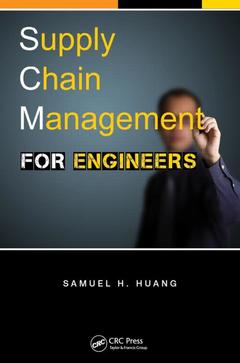Supply Chain Management for Engineers
Auteur : Huang Samuel H.

Originally taught mainly in business schools, supply chain management has become a common elective and graduate course in engineering colleges. The increasing demand for engineers with supply chain knowledge has fed this shift. However, supply chain management textbooks that have a reasonable coverage of quantitative analysis techniques are few and far between. Concise, straightforward, and easy-to-read, Supply Chain Management for Engineers uses practical problems to introduce key concepts and cultivate students problem-solving skills.
Helping students hone their analytical skills and develop the ability to solve real-world problems, the book:
Includes a simulation game for practicing supply chain management skills
Covers the use of practical software tools including Gurobi Optimizer and Microsoft EXCEL
Facilitates the use of problem-based learning (PBL) pedagogy
Provides a theoretical framework for supply chain design and supplier selection
Focusing on quantitative aspects, this book uses example problems to introduce key concepts and case studies to strengthen students analysis and synthesis skills. In addition to exercises, this book also provides several problems that are relatively complicated and can be used as mini projects that link theoretical concepts to practical problem solving. It also presents a simulation game where students can play the roles of suppliers, OEMs, and retailers within a supply chain environment to practice the skills they acquire. It also stresses the importance of integrating engineering optimization techniques with business strategic thinking. These features and more give students the supply chain knowledge and problem-solving skills increasingly required for engineers entering the work force.
Date de parution : 06-2013
15.6x23.4 cm
Date de parution : 07-2017
15.6x23.4 cm
Thèmes de Supply Chain Management for Engineers :
Mots-clés :
Agile Supply Chain Strategy; Lead Time Flexibility; Supply Chain Competitive Advantage; Cycle Service Level; Supply Chain Design and Configuration; Gurobi Optimizer; Supply Chain Simulation Game; Supply Chain Distribution Network; Supply Chain Optimization; Aggregate Plan; Supplier Selection Metrics and Methodologies; AAA Batterie; aggregate planning; Safety Inventory; transportation decision making; Cycle Time; supply chain management; Original DMU; quantitative analysis techniques; Virtual DMU; inventory management; SCOR Model; DVD Drive; Replenishment Lead Time; Exponential Smoothing; Optimal Order Quantity; Laptop Manufacturers; Lead Time Uncertainty; Inventory Balance Constraint; Review Policy; Safety Inventory Level; Backlog Cost; Continuous Review Policy; Periodic Review Policy; Workforce Size


